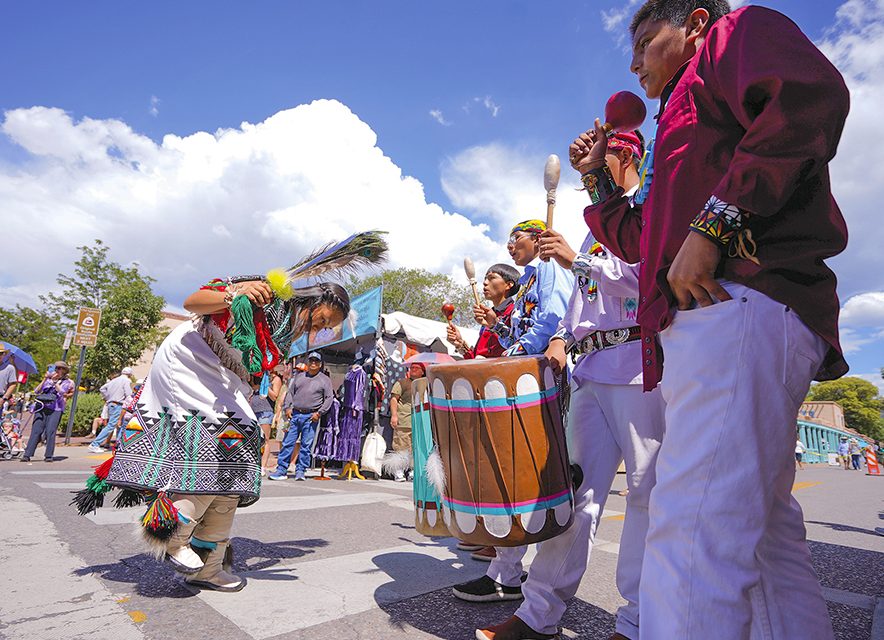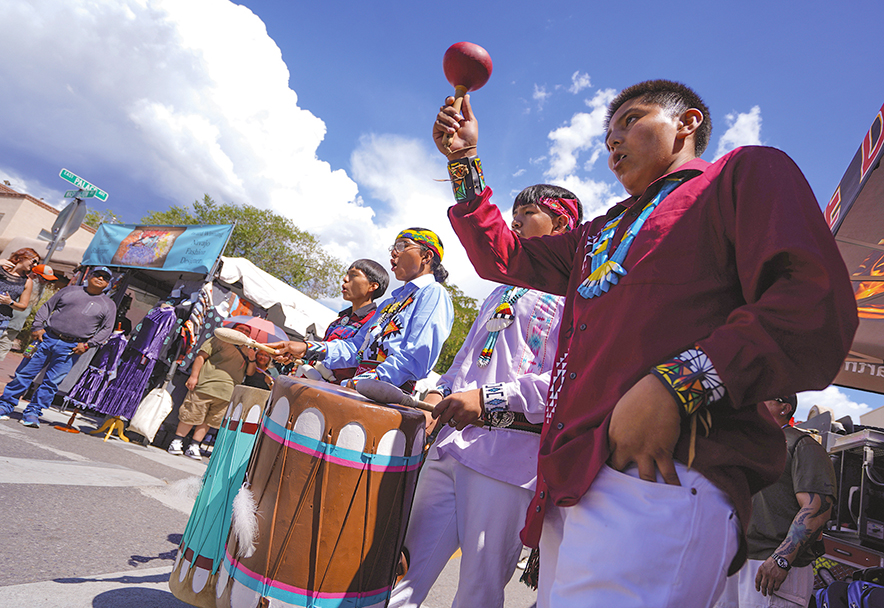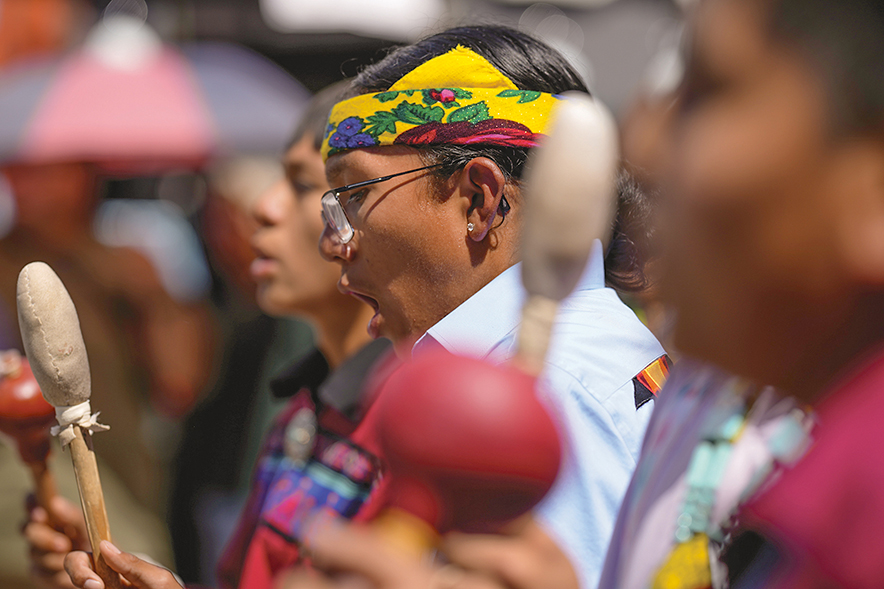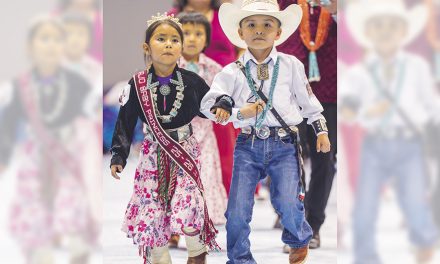
Jemez Pueblo youth embrace tradition through dance and song at Santa Fe Indian Market

Special to the Times | Donovan Quintero
Keean Toya, 14, right, holds his gourd as he sings a Jemez Buffalo dance song on Saturday in Santa Fe.
By Donovan Quintero
Special to the Times
SANTA FE — In a world that often feels disconnected from its roots, a vibrant group of Jemez Pueblo youth is making waves by preserving their culture through the rhythmic movements of traditional dance and the powerful resonance of song.

Special to the Times | Donovan Quintero
Members of the Jemez Pueblo Dance group, from left to right, D-onte Gachupin, Elijah Yepa, Malikai Magdelena, and Keean Toya perform at the Santa Fe Indian Market in Santa Fe on Saturday.
This past weekend, the 102nd Annual Santa Fe Indian Market provided a platform for passionate young performers to showcase their dedication to their heritage, attracting an audience eager to witness the expressions of Pueblo culture.
Among the standout performers were Elijah Yepa, 14, a ninth grader at Jemez Valley High School, and Malikai Madalena, 17, a dedicated twelfth grader from the same institution. Together with their peers, they captivated the audience with a performance that not only highlighted their talents but also paid homage to the centuries-old traditions of their ancestors.
Sharing tribe’s cultural practices
The Jemez Pueblo tribe is one of 19 tribes in New Mexico. According to the tribe’s website, there are more than 3,400 tribal members enrolled.
Yepa and Madalena, two of the tribe’s younger members, were in Santa Fe, not to enjoy the chaotic event the annual Indian market creates, but to share part of their tribe’s cultural practices. Yepa spoke about where he gets his inspiration to sing the song he and his schoolmates sang.
“The inspiration comes from our buffalo dances that come around during wintertime. Usually, these dances are made from praying for snow, praying for snowfall, and for hunters,” said Yepa. “It just feels good to be able to do all this.”
Their sponsor, and perhaps, their elder counsel, Jolene Cruz-Madalena, said the group consists of youth who’ve been dancing and singing since they were three or four years of age, adding the group consisted of several Pueblo tribes.
“This group is very active in their own traditional cultures. They’re all part Jemez Pueblo, and some come from Laguna Pueblo, Ohkay Owingeh, San Felipe,” she said on Saturday.
Cruz-Madalena said youth learning, and practicing, their cultural means to her that it teaches them there are many ways to be successful.
“It also teaches the youth how to balance,” said Cruz-Madalena.
Hopi sculpturer Ron Honyumptewa from Moenkopi, Arizona, who was also at the Indian market selling his kachina dolls, said in his culture, language was an intricate part of their way of life.
“As Hopis, we try to instill our language and culture into our youth,” he said. “My two daughters are heavily involved with our culture and heavily involved with our traditions.”
Honyumptewa remembers learning the Hopi songs and dances at an early age.
“I did learn it from my grandparents, my uncles. I remember the kachinas that came around, the dances that come around. I was very lucky that my grandparents spoke to me in Hopi, so I was able to understand that,” he said.
Overall, according to the Harvard International Review, an Indigenous language is lost every two weeks across the world. A major factor is language suppression practices. In 2021, the Department of the Interior began investigating federal Indian boarding school policies. The investigation revealed the extensive reach of the system, which included 408 schools across 37 states. The Bureau of Indian Affairs found that the primary purpose of boarding schools was to culturally assimilate American Indian, Alaska Native, and Native Hawaiian children by forcibly removing them from their families and discouraging their languages, religions, and cultural beliefs.
Shedding light on harsh realities
The Federal Indian Boarding School Initiative Investigative Report Volume 1 drew on federal documentation to shed light on the harsh realities faced by children in these institutions. Their investigations revealed life was tightly structured with minimal downtime, and living in cramped conditions, often resulting in multiple children sharing a bed.

Special to the Times | Donovan Quintero
Elijah Yepa, 14, from the Jemez Pueblo Tribe, sings a Jemez Buffalo dance song on Saturday in Santa Fe.
The federal government’s treatment of Indigenous people is riddled with numerous dark chapters, yet few are as troubling as the federal government’s efforts to eradicate their languages and cultures in a bid to assimilate them into an American identity. The government’s destructive policy, articulated in the late nineteenth century, aimed to transform Indigenous peoples into what officials envisioned as “white men with different colored skin,” reflecting a profound disregard for their rich cultural heritage.
The first major step in the United States assimilation policy was the tribal land allotment initiated by the General Allotment Act of 1887, commonly known as the Dawes Act. This legislation aimed to encourage Indigenous tribes to use their land more productively while simultaneously opening additional land for white settlers. The Dawes Act mandated that Indian reservations be divided into 160-acre and 80-acre plots, which were individually allocated to heads of Indian households. The act resulted in significant land loss.
The Indian Boarding School era emerged following the removal and reservation policy, as dissatisfaction grew within the federal government due to increased pressure by white settlers moving westward. As more pressure was placed on the federal government, it fueled hostility towards Indigenous tribes that would ultimately contribute to the push for boarding schools aimed at assimilating Native populations into Euro-American culture.
The U.S. government implemented a significant measure to promote assimilation through the reform of Indian education, focusing on the establishment of boarding schools. The institutions aimed to teach Native American children English to expedite the assimilation process.
Captain Richard Henry Pratt played a pivotal role in shaping the structure of Indian boarding schools. He founded the first Indian boarding school, the Carlisle Indian School, in 1879. Following some early successes, he successfully lobbied Congress, leading to federal funding for Carlisle and other boarding schools in 1891. This marked a turning point because solidified the government’s commitment to funding Indian boarding schools, shifting mainstream perceptions regarding the education of Native Americans.
Pratt famously states his policy of “Kill the Indian in him and save the man,” believing that indoctrination into Euro-American capitalist values was essential for achieving this aim.
Caring for environment, ‘Navajo way’
The Jemez Pueblo face group’s sponsor, Cruz-Madalena said practicing dance and singing culturally related songs, as well as dancing appropriate dances, also teaches youth to care for the environment.
“It does teach them to take care of the environment. For example, with the corn that some of them are dancing many of their families are farmers. They have their farming areas. So, a lot of the corn that they may be dancing with or utilizing, they have grown it themselves,” said Cruz-Madalena. “So, they’re learning to take care of the environment and especially keep on that tradition, as well as farming, because a lot of what is used, whether it be for what they’re dancing with, or even as food to put on the table, to welcome individuals when they come into the homes. That’s all coming from their own plants, their own plants, and they’re growing so it does teach them how to take care of the environment and honor the environment.”
Navajo painter Alvin John, from Kayenta, who was also at the Indian market selling his work, said the Diné philosophy is to carry on traditional teachings, the roots, and k’é.
“Right now, we’re kind of losing the language,” said John, who explained how he visually teaches his children and younger generations through his artwork. “This is a way of having them visually looking at it, and they’ll approach you, they’ll ask, ‘What’s the purpose of this? Or why is this color in this way?’ So, we try to explain it to them and tell them that, ‘Hey, this is the way our elderly taught us, without even the English way, the Western way. This is traditional, basically the Navajo way.’”
John said the youth who do and eventually leave the reservation should not lose two things.
“The number one thing would be the language and then their identity, where they’re coming from. Because of our ancestors, we wouldn’t exist. It’s because of them. They got to sacrifice everything they had; and how they were driven off the reservation,” he said. “They had to fight for all that for us to come back as a nation.”
For Yepa, who sang a traditional Jemez Buffalo song with Madalena, D-onte Gachupin, a ninth grader, and Keean Toya, also a ninth grader, he said they didn’t perform for the attention.
“It’s just like what we love to do like we’re not asking for any attention. We are just people who love doing what our tradition is: to try to carry it on for as long as we can,” he said.
Perhaps the eldest of the group, Madalena said in the humblest of remarks that everything they’ve learned came from home.
“We grew up participating and everything we’ve learned now, the songs and dancing, we’re just wanting to continue on and just use everything that we’ve learned from home,” he said. “We’ve been taught by our families and by other singers, and we just want to keep up the be the next generation and keep our tradition alive.”
The market is known for highlighting Native American art, culture, and performance, and draws thousands of visitors from all over the world.
Despite the challenges posed by modernization and the fading of traditional practices in some communities, Elijah and Malikai say they remain optimistic about the future of their culture and other Indigenous cultures. But to preserve it means youth, like them, ensure they listen and participate in their cultural ceremonies.
“They just need to make sure to listen and participate in everything. As much as they can ask, ask questions. If they don’t know a word in their language, ask. Or if they want to learn a song, learn how to make a song, they just ask. They just can’t be afraid to ask to learn more things,” Madalena said.








 Highway 264,
Highway 264, I-40, WB @ Winslow
I-40, WB @ Winslow